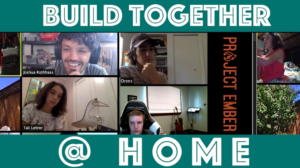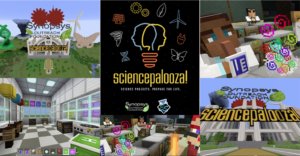Unleashing Creativity with Project Ember
In the realm of education innovation, Project Ember stands as a beacon of creativity and experiential learning. Founded by Katie Richmond and Joshua Rothhaas, Project Ember blends art, engineering, and social-emotional learning to empower children aged 6-17 to explore their imagination and build tangible creations. My collaboration with Project Ember has been transformative, shaping my approach to education and fostering a deep appreciation for student-led learning.
I first crossed paths with Josh while he was working at Brightworks, an innovative school in San Francisco led by Gever Tulley. As a part of the research and design phase at KLS, I visited Brightworks several times and often my team and I met with Josh to study the large scale building that they engaged in with young students. Josh played a pivotal role in bringing Gever Tulley’s visionary educational concepts to life in its summer camp, Tinkering School and at Brightworks, its K-8 school. Josh was also instrumental in growing both programs. Drawn to Josh’s expertise and passion for hands-on learning, I gained a relationship that would profoundly impact my career.
At Project Ember Katie and Josh meant to cultivate a summer camp experience that challenged conventional notions of education. Through immersive group experiences and engaging prompts like “build a summer camp for dogs designed by cats,” campers took on collaborative projects that went way beyond traditional boundaries of learning together by allowing all campers to use real power tools. From constructing a car wash-equipped with a car on a track to building towering rollercoasters, the possibilities at Project Ember’s summer overnight and day camps were endless. Campers are immediately empowered by the massive capabilities that are inherited with power tools and the visceral danger that they are entrusted to work safely with. It is a stunning sight and to date with skill and planning project Ember has never had a major accident.
Inspired by Project Ember’s ethos, I volunteered my time and resources to support their endeavors from the first time Josh told me that he and Katie were starting on the project. I witnessed firsthand the transformative power of student-driven exploration, so I invited Project Ember to hold its first summer camp at RAFT’s headquarters in San Jose, CA.
I continued to give my time and support to Project Ember through its early growth, both to support the program but also to reinforce my teaching practice. I spent several weeks building amazing and huge flying-unicorn-treehouses or whatever kids could imagine at Project Ember. Each one taught me valuable lessons about understanding the experience of a kid attempting a daunting new task, and new strategies for pushing students’ imaginations and engagement beyond what they expect in a traditional classroom. My experience working with campers at Project Ember not only enriched my understanding of educational pedagogy but also equipped me with valuable skills that I could later apply in the classroom.
I had sensed a growing desire to reconnect with the direct interactions and transformative experiences that teaching offers. It was during this time that I spent several weeks immersing myself in the world of Project Ember, guiding campers as they brought their imaginative visions to life.
Working alongside these young innovators provided me with a fresh perspective on education, one rooted in hands-on, experiential learning and student-driven exploration. Through collaborative projects and creative challenges, I witnessed the power of fostering curiosity, resilience, and ingenuity in young learners.
The campers’ boundless enthusiasm and innovative spirit inspired me to tap into my own creativity and adaptability as an educator. I learned to embrace uncertainty, think outside the box, and cultivate a supportive learning environment where students felt empowered to take risks and pursue their passions.
The experience of guiding campers through the process of realizing their dreams instilled in me a deep sense of fulfillment and purpose. It reaffirmed my belief in the profound impact that educators can have on shaping the aspirations and aspirations of the next generation.
Later in my career, around 2021, as the COVID-19 pandemic had prompted a significant exodus of teachers from the profession, I felt a strong pull to return to the classroom and make a meaningful impact on students’ lives. I continued to volunteer and work with Project Ember as I transitioned back to the classroom amid the challenges of the pandemic, I carried with me the lessons and insights gleaned from my time at Project Ember.
In 2019 I was asked by the Projcet Ember leadership team to consider joining them in creating a roadmap for Project Ember’s Future. As I transitioned from my role at the Monterey County Office of Education to join Project Ember’s leadership team in 2020, I was energized by the prospect of expanding the camp’s offerings and securing long-term resources including real estate that would provide a permanent home for the overnight camp.

Build Together @ Home
The onset of the COVID-19 pandemic presented unforeseen challenges. Project Ember faced the daunting task of adapting its operations to continue serving its community of young learners. With traditional in-person camps and events no longer viable, the team rallied together to innovate and create new opportunities for engagement with existing customers ad.
One of the pivotal responses to the pandemic was the launch of Build Together at Home, an online camp designed to bring the magic of Project Ember directly into the homes of campers. Through virtual platforms like Zoom, students were able to participate in hands-on activities, creative challenges, and collaborative projects, all while staying connected with their peers and mentors. Build Together at Home provided a much-needed sense of normalcy and excitement during uncertain times, fostering a supportive and engaging environment for young learners to explore their interests and unleash their creativity.
In addition to the online camp, Project Ember expanded its offerings into the digital realm with the introduction of a Minecraft after school program. What began as a solution to continue engagement during the pandemic quickly evolved into a full-fledged program that transcended geographical barriers. The Minecraft platform provided an immersive and interactive space for students to collaborate, problem-solve, and unleash their imagination. What started as an adaptation to challenging circumstances became a powerful tool for learning and community-building, ultimately expanding to become an after school offering for an entire school district.
As part of Project Ember’s commitment to innovation and educational excellence, the team also created two additional new products directly serving students and teachers. The team attended online meetings with the Region 5 STEAM steering committee to uncover needs and pain points schools, teachers, and students were experiencing. We found plenty. Teachers were inexperienced using the tools and had few practices or strategies for creating engagement online. Many students turned off cameras and microphones for a variety of reasons and disengaged from the zoom calls.
Overwhelmingly the team observed that educators were reporting a lack of engagement with their students and classroom communities. Students frequently turned off their cameras and microphones. technology problems were rampant, and many families had to quickly redesign their living spaces to acommodate several new needs for space and sound. The team had a very differnt experience during our summer Build Together @ Home camps
Through free-for-teachers online workshops, Project Ember provided educators with essential skills and resources to effectively conduct their classes over platforms like Zoom. These workshops covered a wide range of topics, including utilizing Zoom’s features to enhance virtual instruction, fostering student engagement through interactive activities, and creating dynamic and inclusive learning environments online.
One key focus of the workshops was on introducing teachers to innovative and engaging activities designed specifically for online settings. From interactive online games to community meeting activities that promote connection and collaboration among students, Project Ember equipped educators with a diverse toolkit of strategies to keep students actively engaged and motivated in virtual learning environments.
Project Ember’s workshops also delved into the realm of creative expression, offering guidance on facilitating collaborative online artmaking activities. These activities not only provided students with an outlet for self-expression but also fostered a sense of community and teamwork, even in virtual settings.
By empowering teachers with the knowledge and resources needed to effectively navigate online instruction, Project Ember played a vital role in supporting educators during a time of unprecedented challenges. Through its commitment to providing high-quality training and support, Project Ember demonstrated its dedication to advancing education and empowering teachers to thrive in virtual learning environments.
Sciencepalooza
 After a meeting with the Region 5 STEAM steering committee we were approached by an organization that helps to put on an annual science fair in the East Bay Science Fair named Sciencepalooza. The event would be cancelled as no in-person location existed for a large event supporting multiple high schools during the outset of the COVID pandemic. Interested in our presentations about engaging students with our Build Together @ Home, the group asked us for ideas that could allow the Sciencepalooza to occur as an engaging online event. Our team proposed a This virtual event brought together students from across the region to showcase their scientific prowess and creativity in a digital format. Participants had the opportunity to design and present their projects within the virtual world of Minecraft, fostering a sense of excitement and discovery despite the limitations imposed by the pandemic. Sciencepalooza not only provided a platform for students to share their work but also highlighted the resilience and adaptability of Project Ember in the face of adversity.
After a meeting with the Region 5 STEAM steering committee we were approached by an organization that helps to put on an annual science fair in the East Bay Science Fair named Sciencepalooza. The event would be cancelled as no in-person location existed for a large event supporting multiple high schools during the outset of the COVID pandemic. Interested in our presentations about engaging students with our Build Together @ Home, the group asked us for ideas that could allow the Sciencepalooza to occur as an engaging online event. Our team proposed a This virtual event brought together students from across the region to showcase their scientific prowess and creativity in a digital format. Participants had the opportunity to design and present their projects within the virtual world of Minecraft, fostering a sense of excitement and discovery despite the limitations imposed by the pandemic. Sciencepalooza not only provided a platform for students to share their work but also highlighted the resilience and adaptability of Project Ember in the face of adversity.
Return to In-Person Camps
Despite the uncertainty of the times, Project Ember remained steadfast in its commitment to student-centered learning and safety. We invested heavily in COVID safety measures, ensuring that testing and PPE were readily available for all participants. Our resilience and adaptability not only sustained us through the pandemic but also expanded our reach, forging partnerships with school districts to deliver online learning experiences.
As I reflect on my journey with Project Ember, I am filled with gratitude for the opportunity to collaborate with such a visionary organization. Together, we have demonstrated the boundless potential of hands-on learning and fostered a community of creative thinkers. As we navigate the challenges of the future, let us continue to embrace innovation and empower the next generation of builders and dreamers.
